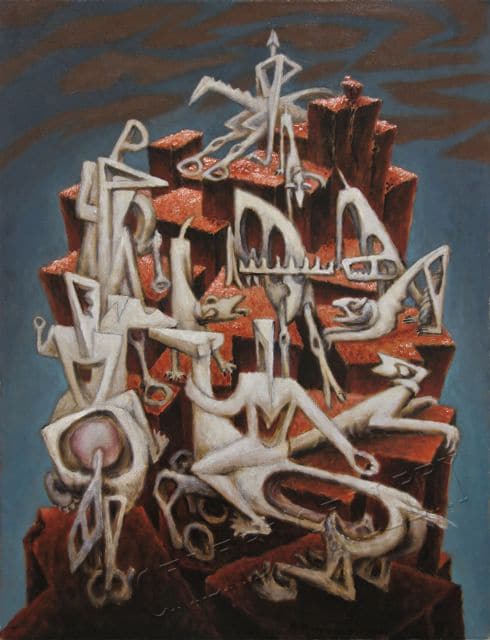Robert B. Howard
Robert Boardman Howard (New York, NY. September 20, 1896 – February 18, 1983)
Quarry’s End by Robert B. Howard, 1946, Oil on Canvas, 34×26 Exhibited at The Walker Art Center 1947, The Syracuse Museum of Fine Arts 1947 & The California Palace of the Legion of Honor 1947-48
Born 1896 to John and Mary Howard, Robert was the eldest of the Howard brothers and the most introverted. He, along with his brothers, was originally born in New York, but the family moved to Berkeley upon his father accepting the job as head architect and professor of architecture for University of California, Berkeley. Described as somewhat of a “paradox” (Moss, The Howards, 34), Robert was an introverted, yet theatrical clown who was known to deliver a good knee-slapper of a joke, a tall, blonde, good looking man that could command the attention of the room without saying a word. However, a speech and hearing impairment pushed the young Robert further into seclusion, often entertaining himself by experimenting with lead and tree sap, stretching and molding them and turning them into various figures. It was this isolation that pushed him into an artistic direction from a young age, but just like his brother John, was also fascinated by engineering and machinery which led him to dabble in an array of mediums.
After a long standing struggle with public school, the young Howard’s father pulled him out and moved his education to home, hiring Arthur Upham Pope to educate Robert. Among teaching him the general ed’s, Pope imbedded his pupil with a passion for Egypt that only grew with age, leading him to visit the country a total of seven times throughout his life. Eventually the young artist was able to reintegrate himself into the public school system and carried on his education at (what is known today as) California College of Arts and Crafts, Oakland where he then threw himself into painting. Like his brothers, Robert was born with the traveling bug but also a nature boy and enjoyed many physical pursuits that fully immersed him in nature and explored much of California by way of hiking. In 1916, Robert called it quits on school again and left for the road with Charles on his motorcycle before entering the Arts Student League in New York, however returned to Berkeley the following year. He then entered into the army and was promptly sent to France to work as a motorcycle dispatch rider for the American Field Service in WW1. After the war, Robert settled in Paris, a right of passage for artists of this time. He threw himself into painting and fully immersed himself in the city’s artistic oeuvre and re-enrolled in school at Académie de la Grande Chaumière. In 19221 went home to San Francisco to launch his first solo exhibition at Print Rooms Gallery which pushed him towards further exploring various areas of art such as wood carving and architectural ornamentation which took off in New York and San Francisco. He became a diligent figure in the San Francisco art community in 1927 and was shown by new associates in the Modern Gallery which focused on new fresh artists, one of them being his future wife, Adeleline Kent. Robert, a lover of machinery, eventually poured this passion into his art which was shown at the Puppet Players Theatre which received five star reviews, one critic raving that “I have seen living, breathing sculpture. I have experienced the delight of seeing beautiful wood carving come to life and bring into ecstatic reality those gentle gestures one imagines while dreaming over a favored sculpture…”.
The next year Robert set out for another trip abroad with the intention of studying relief sculptures throughout Egypt, Persia, India as well as the South Seas. His letters were widely praised when published in the notable magazine known as The Argus. The 30’s-40’s were a triumphant year for Robert, he was a respected figure of the Art Association which was considered to be the heart of the Bay Area and had several commissions. The 40’s were highly dedicated to his architecture and steered further from painting and his architectural sculpture known as Eyrie, a sculpture meant to incorporate his love of nature, snagged him instant recognition and an award for an exhibition called Most Distinguished Work of Art. He started experimenting with other materials such as fiber glass, giving the public a chance to fully interact with the art. 1945-’52 Robert taught at the California School of Fine Arts, known today as San Francisco Art Institute where he was brought on by Douglas MacAgy to teach sculpture at the institute. Despite Robert’s extensive travel during this time, both he and his wife, Adeline always enjoyed interacting with their community and were known to throw Christmas parties that were adorned with beautiful food and decorations and oftentimes had the school’s jazz band provide entertainment for the guests. Robert never retired from art and continued exploring different aspects of it for as long as his body allowed him, he had his last exhibition in ‘76 at the age of 80 and died peacefully six years later in Santa Cruz. His art continues to have a strong presence today.



 And many more
And many more